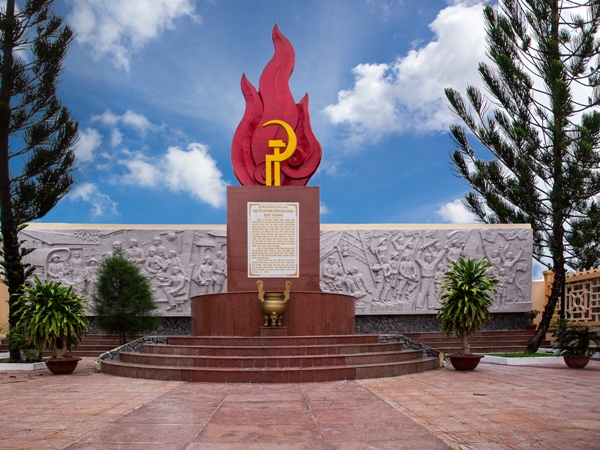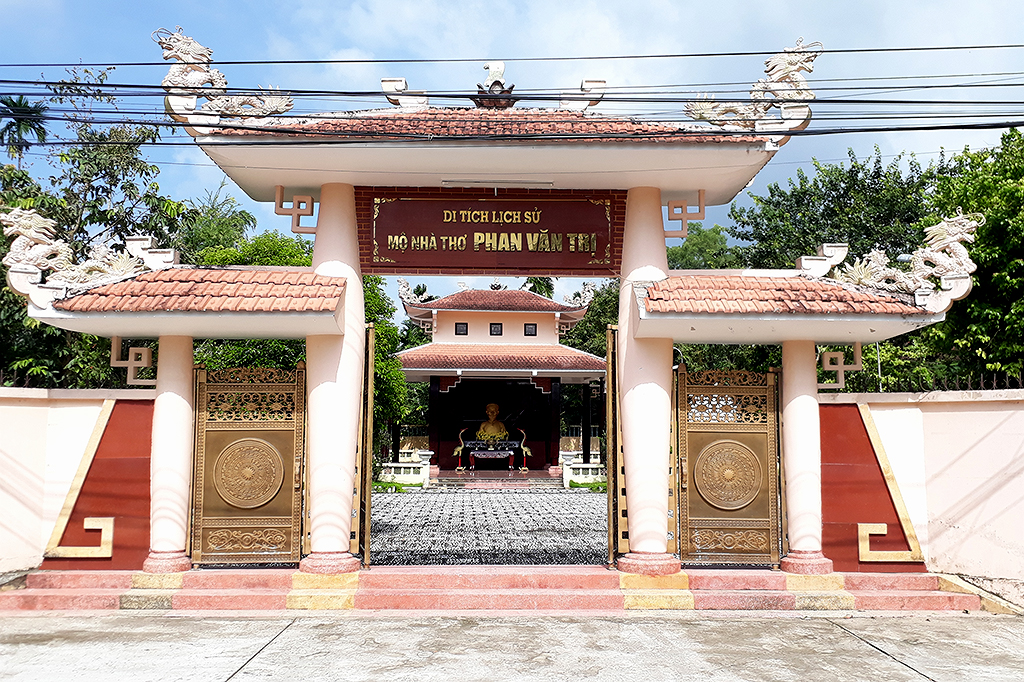Relic point Vietnam
Việt NamNam Nha Pagoda
Nam Nha Pagoda or Nam Nha Duong, full name is Nam Nha Phat Duong, located at 612 Cach Mang Thang 8 Street, Bui Huu Nghia Ward, Binh Thuy District, Can Tho City. This is not only a place for religious activities of followers of Minh Su religion, but also a base for revolutionary activities of patriotic movements in Can Tho in particular and the South in general in the late 19th and early 19th centuries. twentieth century. The founder of Nam Nha Pagoda was Mr. Nguyen Giac Nguyen (1850-1919), alias Nguyen Phuong Thao, religious name Long Khe Tao Nhan, religious name Nguyen Dao Co. Around 1890, Mr. Nguyen Giac Nguyen began participating in the Dong Du movement. At first, he moved his house from Rach Sao to Binh Thuy market and set up Nam Nha Duong herbal medicine shop near Rach Mieu bridge as a communication base against the French. In 1895, Mr. Nguyen Giac Nguyen stopped working as a Chinese medicine shop and moved to Binh Thuy river to establish a small three-room pagoda also named Nam Nha Duong. In 1905, the pagoda was reconstructed on a larger scale with five rooms and two wings. Over time, the pagoda was damaged a lot. People in the religion wanted to rebuild it, but France did not allow it because the pagoda was still under surveillance. They had to lobby with the French authorities to be allowed to build. In 1917, the pagoda was rebuilt with bricks and tiles, many materials were ordered from France. Like many other temples, Nam Nha Pagoda was built near the riverbank so that visitors from all over could conveniently come and worship, because traffic in the past was mainly by waterway. Therefore, the temple gate also faces Binh Thuy canal. Many documents describe the temple gate as built of bricks and tiled. The pagoda's yard is paved with Chinese tiles, surrounded by a large garden stretching out to the banks of the Binh Thuy River. In the middle of the garden is a rockery over 2m high placed in a water tank built of bricks. In the garden, there are many pine trees, cypress trees and other ancient trees. The main hall is a solid brick house, consisting of 5 rooms, roofed with yin and yang tiles, and has a picture of two dragons and pearls on it. In particular, the main hall's facade has a combination of Asian and European architecture in the early twentieth century, and is quite different from the traditional pagoda style in the South. Inside the main hall, the central area is decorated very solemnly, used as a place to place the altar of the Three Teachings Saints (there are three bronze statues of Shakyamuni Buddha, Most Holy Confucius and Lao Tzu). Dao To). Behind the main hall is a long hallway with two reception rooms. To the right and left of the pagoda are two rows of tile-roofed houses called Can Dao Duong (Dong Lang row) for men and Khon Dao Duong (Tay Lang row) for women, connected to the kitchen. Currently, Nam Nha Pagoda also has many fields and gardens, especially behind the pagoda is a green garden of fruit trees and ornamental flowers, cooling the quiet space of the pagoda. In addition to religious activities, Nam Nha Pagoda is also a base for revolutionary activities. The pagoda is "the operational headquarters of the Dong Du movement in Can Tho. Here, in February 1913, after returning from France, patriot Cuong De and Mr. Nguyen Giac Nguyen discussed national affairs to mobilize the patriotic movement in the South, but were discovered by the French colonialists. The temple should be closed. However, this place continues to remain a secret base for revolutionary activities. In 1929, when the Special Committee of the Annam Communist Party of Hau Giang was established in Binh Thuy, Nam Nha pagoda was the contact base between the Special Committee of Hau Giang and the Southern Party Committee of revolutionaries, including comrade Ngo. Gia Tu, Secretary of the Provisional Party Committee of the Southern Party Committee. During the two resistance wars against the French and the Americans, Nam Nha Pagoda was always associated with the cause of national liberation. With such architectural and historical values, on January 25, 1991, Nam Nha Pagoda was ranked as a national historical relic by the Ministry of Culture, Sports and Tourism. Source: Can Tho Newspaper online
Can Tho 3983 view
SPECIAL SECURITY COMMISSIONER OF THE SOUTH COMMUNIST PARTY HAU GIANG
Historical relic of the Special Committee of the Communist Party of the An Nam Communist Party. On the way to Long Hoa ward, Long Tuyen (Binh Thuy district, Can Tho city), on the right hand side is a house numbered 34/7 Bui Huu Nghia street, Binh Thuy ward. , Binh Thuy district used to be a house rented as an agency of the Special Committee of the An Nam Communist Party of Hau Giang Party. Historical relic of the Special Committee of the An Nam Communist Party of Hau Giang In the middle of September 1929, a very important event for the Hau Giang region's Party Committee took place here. That was the conference to establish the organization "Special Committee of the Annam Communist Party of Hau Giang" chaired by comrade Chau Van Liem and directed to elect the Executive Committee of the Special Committee including comrades: Ung Van Khiem, Ha Huy Giap, Nguyen Van Tay, Nguyen Van Tri... with comrade Ung Van Khiem as Secretary. After 5 months of operation, the Annam Communist Party Special Committee of Hau Giang Party has built Party bases throughout the Hau Giang region, making an important contribution to unifying the Party into a single Party organization, to lead the movement. Viet Nam's revolution. After February 3, 1930, the three party organizations were unified into the Communist Party of Vietnam, the Special Committee under the Southern Party Committee. Comrade Ung Van Khiem was assigned to be a Standing Member of the Southern Party Committee. Comrade Ha Huy Giap as Secretary of the Hau Giang Special Committee. In April 1930, due to the need to preserve the Special Committee, the Special Committee moved to Sa Dec province. The Annam Communist Party Special Committee has historical value, has laid the first foundation, and is an important premise in building and developing the Party Committee and revolutionary movement in Hau Giang provinces. Therefore, on January 25, 1991, the Ministry of Culture and Information recognized the An Nam Communist Party Special Committee of Hau Giang Party as a national historical relic. In 1995, the People's Committee of Can Tho City together with the people of Binh Thuy ward built a monument commemorating the Special Commissar of the An Nam Communist Party of Hau Giang, in Binh Thuy ward. Source: Can Tho tourism information portal
Can Tho 3881 view
TOMB OF POET PHAN VAN TRI
The historical tomb of poet Phan Van Tri is located in Nhon Loc 1 hamlet, Phong Dien town, Phong Dien district, Can Tho city. This is the resting place of patriotic poet Bachelor Phan Van Tri, a Confucian scholar who used poetry as a weapon to fight for the survival and development of the nation throughout his life and was known by people as the poet - soldier. The grave site was recognized as a national monument in 1991. Previously, the poet's grave was only built of simple cement, located in the middle of a green lawn with a tombstone. In 1990, with the respect of the people, people joined hands to restore the tomb of poet Phan Van Tri with polished stone, the tomb went up the steps, with a splendid polished stone epitaph, with a fence, Having green grass creates a bit of poetry, beauty, and a bit of an edge like the courage of the pen and the temperament of the poet when he was alive. By 2005, the relic was restored on a larger scale, on an area of 2,060 m2. Includes items: Memorial house, Exhibition house, grave, books and stone steles (recorded with famous verses of Bachelor Phan Van Tri), lotus pond, ornamental plants, waiting room... . The most impressive thing on the grounds of the tomb is the stone stele, built based on inspiration from the poet's pen on the page. The pen's nib is facing up, in the middle are his famous poems. Right behind the memorial is a portrait statue of poet Phan Van Tri built full of soulfulness and sincerity. Poet Phan Van Tri was born in 1830 in Thanh Phu Dong commune, Giong Trom district, Ben Tre province, into a Confucian family, respectful of morality and rich in patriotic traditions. From a young age, he was famous for his intelligence and passed his bachelor's degree at the age of 20 at the Huong exam of Gia Dinh school in 1849. Although he was a scholar of Confucianism, he was faced with the policy of exploiting the people too heavily and the policy of banning religion and closing the door. The Nguyen Dynasty's court blockade brought the country to a point of weakness, making him extremely disappointed and he did not become an official but retired to enjoy teaching and poetry. In Gia Dinh, he participated in founding the group "Bach Mai Thi Xa". This is the place where scholars, scholars, and guests gather to recite poetic poems. In 1858, the French colonialists opened fire to attack Da Nang, starting the war of invasion of our country. At this time, Phan Van Tri moved to Binh Cach village, Tan An (now in Tien Giang province), then returned to Vinh Long to open a school to teach and collect medicine for poor people. In 1868, Phan Van Tri returned to Nhon Ai village, Phong Dien in Can Tho province to reside, continued to open a school to teach and compose poetry criticizing mandarins who "forever sought national glory", and at the same time praised the morale of the people. patriotic soldiers and scholars. Each line of his poetry is imprinted with a soul filled with patriotism, love for the people, and decisive distinction between friends and enemies. On May 16, Canh Tuat year (June 22, 1910 of the solar calendar), patriotic poet and bachelor Phan Van Tri rested in Nhon Ai village, Phong Dien in a simple thatched house with a pure heart. of him, leaving behind so much regret among the people. The resting place of Bachelor Phan Van Tri has always been restored and preserved by local people through generations. Currently, the Historic Tomb of Poet Phan Van Tri has become a place for sightseeing, studying, traditional activities, and cultural exchange. In particular, on June 22 of the solar calendar every year - on the occasion of the death of Bachelor Phan Van Tri, local authorities and people in the area organize a very solemn death anniversary ceremony and cultural and artistic activities to commemorate the death. remembering a poet - a soldier, creating an annual festival of the Monument in particular, of Phong Dien district and Can Tho city in general. Source: Can Tho tourism information portal
Can Tho 4128 view




